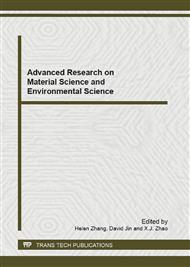[1]
George Karavalakis, Stamoulis Stournas, Evangelos Bakeas. Effects of diesel/biodiesel blends on regulated and unregulated pollutants from a passenger vehicle operate over the European and the Athens driving cycles [J]. Atmospheric Environment, 43, 1745-1752. (2009).
DOI: 10.1016/j.atmosenv.2008.12.033
Google Scholar
[2]
Zervas, E., Poulopoulos, S., Philippopoulos, C. CO2 emissions change from the introduction of diesel passenger cars: case of Greece [J]. Energy 31, 2579-2589. (2006).
DOI: 10.1016/j.energy.2005.11.005
Google Scholar
[3]
Knottenbelt C. Mossgas gas-to-liquid, diesel fuels-an environmentally friendly option [J]. Catalysis Today, 71(3/4): 437. (2002).
DOI: 10.1016/s0920-5861(01)00471-0
Google Scholar
[4]
Heng H C, Idrus S. The future of gas to liquid as gas monetization option [J]. Journal of Natural Gas Chemistry, 13, 63. (2004).
Google Scholar
[5]
Lou Diming, He Rui, Hu Zhiyuan, Tan Piqiang. Road-test Emission Research of PASSAT Diesel Taxi Fueled with Gas-to-Liquid Fuel [J]. Automotive Technology, 5, 15-18. (2007).
DOI: 10.1109/iceice.2011.5777094
Google Scholar
[6]
KAWAMOTO Keiji, ARAKI Takashi, SHINZAWA Motohiro, et al. Combination of combustion concept and fuel property for ultra-clean Dl diesel. Society of Automotive Engineers, 113, 884-892. (2004).
DOI: 10.4271/2004-01-1868
Google Scholar
[7]
Oguma, M., Goto, S., Oyama, K., Sugiyama, K., et al. The Possibility of Gas to Liquid (GTL) as a Fuel of Direct Injection Diesel Engine [J]. SAE Technical Paper 2002-01-1706, 2002, doi: 10. 4271/2002-01-1706.
DOI: 10.4271/2002-01-1706
Google Scholar
[8]
Sun Wanchen, Li Guoliang, Ma Yigong, et al. Effects of GTL/diesel blended fuel on combustion from small diesel engine [J]. Journal of Jilin University (Engineering and Technology Edition) 2010, 40(06): 1507-1512.
Google Scholar
[9]
Kitano, K. Misawa, S. Mori, M. Sakata, et al. GTL Fuel Impact on DI Diesel Emissions [J]. SAE Technical Paper, 2007-01-2004, 2007, doi: 10. 4271/2007-01-(2004).
DOI: 10.4271/2007-01-2004
Google Scholar
[10]
Gunfeel Moon, Yonggyu Lee, Kyonam Choi, Dongsoo Jeong. Experimental study on characteristics of diesel particulate emissions with diesel, GTL, and blended fuels [J]. SAE Technical Paper 2009-24-0098, 2009, dio: 10. 4271/2009-24-0098.
DOI: 10.4271/2009-24-0098
Google Scholar
[11]
Hu Zhiyuan, Zhao Jie, Tan Piqiang, Lou Diming. Performance and Emissions Characteristics of a Common Rail Diesel Engine Fueled with Natural Gas-to-Liquid Fuel [J]. Chinese Internal Combustion Engine Engineering, 2009, 30(1): 19-26.
DOI: 10.1109/iceice.2011.5777094
Google Scholar
[12]
Lou Diming. Study on Combustion and Emissions characteristics of Gas-to-Liquid (GTL) in Diesel Car Engine [D]. Doctoral Dissertation of Tongji University, 2007. 03.
Google Scholar
[13]
Pan Hansheng, Chen Changhong, Jing Qiguo, et al. A case study of the emission characteristics of light-duty diesel vehicle and the distribution of vehicle specific power [J]. Acta Scientiae Circumstantiae, 2005, 25(10): 1306-1313.
Google Scholar
[14]
United States. Environmental Protection Agency. Methodology for Developing Modal Emission Rates for EPA's Multi-scale Motor Vehicle and Equipment Emission System. EPA420-R-02-027. Washington DC: EPA, (2002).
Google Scholar


